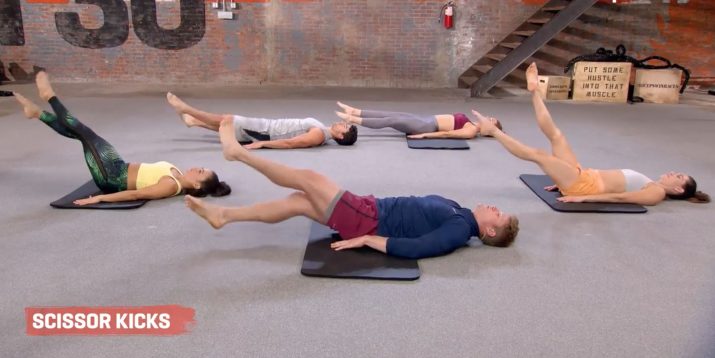How to Do Scissor Kicks

Many of us want to get maximum benefits from each and every exercise in our workout routine. We don’t have time to waste! So when it comes to core exercises, consider turning to the scissor kicks ab exercise, which is the ultimate multi-tasker.
Not only do scissor kicks work virtually every muscle in your core — including your aesthetic six-pack muscles — they also build hip and thigh strength and offer a cardio boost.
Here’s how to reap the many benefits of the scissor kicks exercise.
Scissor Kicks: Step-by-Step Instructions
- Lie on your back with your arms down by your sides.
- Lift both of your legs a few inches off the ground and separate them slightly into a “V” shape. Engage your core and press your lower back into the floor.
- Keeping both legs straight, bring your legs together and cross your right leg over the left. Widen your legs into a “V” again, and then bring your legs together again, this time crossing your left leg over the right.
- Continue alternating until you’ve completed all reps.
- Always keep your lower back pressed into the floor. If it starts to arch, lift your legs up to reduce tension on your core.
Variations on Scissor Kicks
There are many ways to change up the scissor kicks exercise to fit your current ability and fitness level.
- Make it easier: If standard scissor kicks are too intense, Beachbody fitness expert Cody Braun suggests bending one leg and putting that foot on the floor, and moving the other leg back and forth while straight. Switch sides to perform an equal number of reps with both legs.
- Make it harder: If you want to bump up the intensity, Braun suggests adding in a hollow body position, which makes your core muscles work even harder to keep you stable with less floor support. Here’s how to do it:
- Lay on your back and place your hands gently behind your ears with your elbows wide.
- Lift your head and shoulders off the floor into a partial crunch and keep your neck neutral; don’t hold up your head with your hands or tuck your chin.
- Cross your legs back and forth, making sure to keep your lower back pressed into the floor.
- There’s also another way to perform this exercise that is sometimes referred to as a flutter kick. It’s similar, but instead of crossing your legs, you just move them up and down.
What Muscles Do Scissor Kicks Work?
Like other core exercises, this targets the muscles in your abdomen that are responsible for keeping your trunk and spine stable, Braun explains:
- Rectus abdominis
- Obliques
- Transverse abdominis
Additionally, scissor kicks offer the added benefit of working some muscles in your lower body, because you’re crossing your legs:
- Hip abductors (which draw your legs out to the sides)
- Inner thigh muscles
And because you’re constantly moving in this exercise, it can be a great addition to any cardio circuit. Performing scissor kicks during a cardio circuit will keep your heart rate elevated while you work your core muscles. This way, you don’t waste time doing separate cardio and core sessions.



